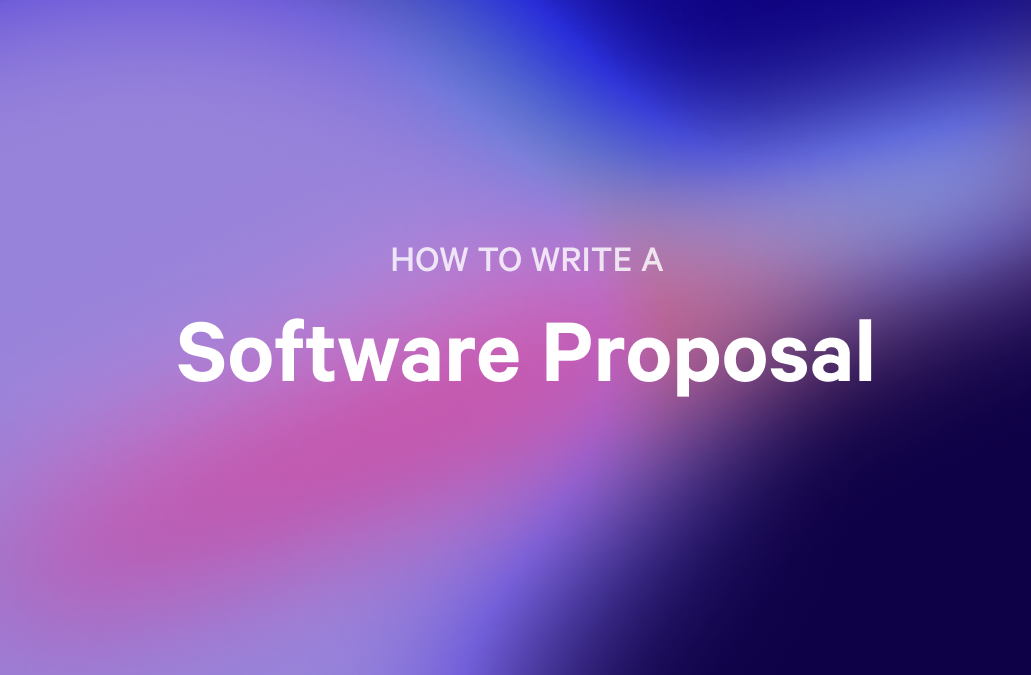A public relations proposal is a type of proposal that outlines the strategies, activities, and objectives of a public relations campaign. This document is crucial in the sales process, as it enables PR agencies and clients to set clear goals, expectations, and budgets for a successful PR campaign.
The main purpose of a public relations proposal is to persuade potential clients or stakeholders to invest in a specific PR campaign or project. To help close the sales deal, the proposal should clearly outline how the proposed strategy or campaign will benefit the business. It needs to outline all the elements involved in bringing the campaign to a successful resolution.
You can see an example of our professionally designed PR proposal template below:
Eight steps to write a public relations proposal: key elements to include
Writing a PR proposal should follow one main goal: to convince potential clients that the proposed PR campaign will meet their objectives and deliver results. In order to do that successfully, there are some steps you will need to take and elements that must be included when you write your sales proposal. These are:
1. Create a great executive summary
The first section of your proposal should be a concise summary outlining the key elements of your campaign suggestion. This element will "hook" your prospect, so be sure to include a visually attractive cover and a compelling look at your plan.
This summary should grab the attention of potential clients and briefly explain why they can benefit from your services. Keep it short and impactful, highlighting key points such as:
- Objectives
- Target audience
- Proposed strategies
- Expected results
Remember also to include a quick overview of your agency. This can be a pre-written introduction showcasing your team and media contacts and a high-level overview of previous successes.
2. Offer a quick situational analysis
A situational analysis is an in-depth examination of a company's current position, taking into account internal and external factors that may impact the success of a PR campaign. This section should assess the customer's strengths, weaknesses, opportunities, and threats to provide context for your proposed strategies.
Some questions to consider include:
- What are the company's unique selling points?
- What are their current communication channels and messaging?
- What are the potential challenges they may face during a PR campaign?
3. Include market research results
Market share lends your strategy credibility and helps show you understand your client's industry and competitors. Showcasing some market research, statistics, or industry trends can also help convince potential clients of the validity of your proposed strategies.
4. Make an audience & awareness review
Show your customer you understand who the campaign is targeting and how it will promote brand awareness. Your audience review should highlight demographics, behaviors, interests, and pain points to prove that you comprehensively understand their target market.
5. Explain strengths & weaknesses
Once you understand your client's needs and target audience, the next step is to propose various strategies that could help achieve their objectives. This section should outline the pros and cons of each strategy, explaining how they align with the customer's goals and budget.
6. Include the goals and objectives
Explain what your campaign goals and objectives are. The key difference between a goal and an objective is that a goal is an overarching aim, while objectives are specific, measurable steps to achieve the goal. Clearly define both in this section and explain how they will be met.
7. Showcase the strategic plan
This is where you explain the actual plan, from A to Z: what you plan to do to help the company reach its objectives. This section should include the following elements:
Target audience
The target audience is the specific group of individuals that your PR campaign seeks to reach, influence, and engage with. Understanding your target audience is vital as it allows for more strategic and effective communication, ensuring that your PR efforts resonate with those most likely to react positively and take action, thereby improving the overall success of your campaign.
Target media
Target media refers to the specific channels through which you plan to disseminate your PR messages, such as newspapers, magazines, TV channels, blogs, podcasts, or social media platforms. Selecting the right media outlets is critical as it affects the reach and impact of your PR campaign, ensuring your messages are delivered to your target audience most effectively.
Key message
What is the main message you want to share with your audience? What should they think or do once they see or interact with your campaign? Explain this as briefly as you can, so you can convince your prospect that your campaign idea is worth their attention (and budget).
Tactics
Your tactics are the specific actions you will take to spread your key message to your target audience through your chosen media outlets. This could involve creating press releases, organizing events, leveraging social media influencers, or creating compelling content that aligns with the interests and needs of your target audience.
Timeline
Provide an estimated timeline for the PR campaign, outlining when each tactic will be implemented. This allows clients to understand the schedule and flow of the campaign activities.
Budget
A detailed budget gives a clear picture of the costs involved in the campaign, including fees for agency work, media buying, event organization, content creation, and any other expenses. Providing a transparent, itemized budget helps build trust with the client.
Measure of success
Lastly, but crucially, define how you will measure the success of the campaign. This could be through media impressions, website traffic, lead generation, sales, or other measurable outcomes. This shows the client how you will track and prove the effectiveness of your PR efforts.
Campaign tactics
This is where you list out and explain each tactic in detail. For example, if your proposed tactic is to organize an event, describe the intended purpose of the event, potential venues, target audience, and expected outcomes. If your tactic is to create a media relations campaign, outline how you will pitch stories and secure media coverage.
Campaign timeline
Draw a timeline that shows the various stages of the campaign and when each tactic will be executed. This helps clients visualize the scope and duration of your proposed campaign -- and it helps you show them you have more than just a high-level idea but an actionable, step-by-step plan on what to do at each stage of the campaign.
Expected results
In this section, explain what results you expect to achieve with your campaign in measurable terms. This could include an increase in media coverage or website traffic, a specific number of leads or sales generated, or improved brand awareness and reputation within the target audience. Providing expected results helps set realistic expectations for your client and shows them how their investment in the PR campaign will pay off.
Project scope
The project scope section is where you outline the scope of work that you will cover in your PR campaign. This could include the number of press releases, events, media coverage opportunities, or social media posts that you plan to produce and execute. Providing a detailed project scope helps clients understand what they can expect from your services and ensures that both parties are on the same page regarding the deliverables.
Evaluation
Last but not least, include a quick overview of how you will evaluate your campaign's success once it has concluded. This could include a post-campaign review of media coverage and engagement, a comparison of expected versus actual results, and any key learnings or insights gained from the campaign. Clients appreciate when you provide them with data-backed evaluations as it demonstrates your commitment to delivering tangible results.
8. Detail your pricing
Your sales proposal should also include a clear, detailed pricing table that breaks down the costs of each service and tactic offered. This helps clients understand how their budget will be allocated and allows for transparency in the pricing process. Be sure to itemize each cost, including any additional fees or expenses that may arise during the campaign. This will help avoid any confusion or surprises later on.
Remember that everything leading up to the pricing or budget outline should underline the value your customer is getting from your services. Show them how you will help them achieve their objectives and what makes your PR services stand out.
Make your PR proposal stand out with these three tips
The best sales proposals go the extra mile -- they're creative, personalized, and leave a lasting impression. Here are three tips to make your PR proposal stand out from the rest:
1. Start with a discovery meeting
This might sound basic, but it can make a difference in how you build a relationship with your prospect. You want to understand who your customer is, what they do, and why they need you. This is at the core of most effective sales methodologies. More importantly, you want to understand their audience and how they interact with them. A discovery meeting is essential in understanding all these elements to create a proposal addressing their needs.
Some of the questions to ask at this stage include:
- What is the company's mission and values?
- Who are their target audience, and what channels do they use to communicate with them?
- What public relations activities have they done, and what were the results?
2. Create a professional-looking design
Theoretically, you can create a simple PR proposal in a Google Sheets spreadsheet or a Doc, download it as a PDF, and call it a day.
But that wouldn't serve you very well.
You need to look professional -- because that's exactly how you will make your customer look too. You need to show you know what you're doing and that you're worth every penny. So invest in a professional design that includes your logo, some on-brand elements, and high-quality images or graphics.
3. Incorporate social proof
Part of why people buy things is because other people buy them. When you include social proof (customer quotes, testimonials, case studies) in your sales proposal, you show that other people trust and have seen success with your services.
Social proof can help build credibility and trust with your prospect and give them the reassurance they need to sign on as a client. So don't be shy about showcasing your past successes and happy clients - it could make all the difference in closing the deal.
Example of public relations proposal template
Want to speed up your sales productivity, ensure consistency, and make sure you never miss the mark on what your proposal needs to include?
Get a public relations proposal template. For example, the Qwilr PR proposal template comes with everything you need:
- A clean, professional-looking design
- Infinite customization options
- All the proposal elements you need, including (but not limited to:)
- Executive summary
- Target audience and key messages
- Strategic Plan
- Market research showcase
- Project breakdown
- And more.
Essentially, all you have to do is add your own branding and client specifics to the proposal template. It also comes with a built-in eSignature, allowing your prospect to sign off on your proposal directly in the document - no more back-and-forth emails or printing, signing, and scanning documents. Just good, old-fashioned sales conversations (but with a modern, efficiency-driven twist).
Alternatively, spin up a professionally designed proposal in minutes using our AI proposal generator.
FAQs
What’s the best format for a public relations proposal?
The best format for a public relations proposal ticks the following boxes:
- It sets the stage (with a smart executive summary)
- It explains the proposed campaign (including market research, strategy, and timeline)
- It outlines the costs of running said campaign (emphasizing the value it provides.)
Final thoughts
People frequently perceive PR as intangible and hard to measure, which makes it difficult to sell, particularly in times of economic uncertainty.
It doesn't have to be this way, though. A good, well-written, cohesive, and comprehensive public relations sales proposal can make all the difference in convincing your prospect to invest in your services. It can help you outline not just what you plan to do, but the actual value your customer's getting out of it, too.
Remember your proposal should be about them, not you -- highlight how your services will help them achieve their goals. Take your time to understand your prospect's business, audience, and challenges to write targeted, personalized proposals that stand out and close the deal.
And make your processes simpler by using a template. It can save you time, make your proposals look more enticing, make it easy for clients to share them with their stakeholders, and ultimately help you land more clients.
About the author

Marissa Taffer|Founder & President of M. Taffer Consulting
Marissa Taffer is the Founder & President of M. Taffer Consulting. She brings over 15 years of sales and marketing experience across various industries to a broad range of clients.


